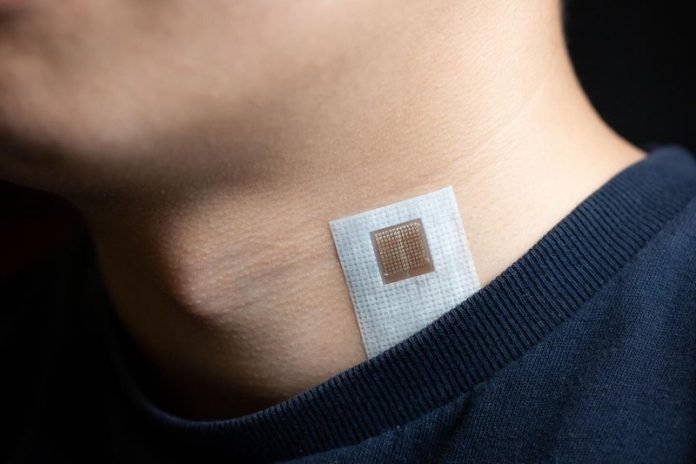
In a new study from the University of California San Diego, researchers have developed a soft and stretchy ultrasound patch that can be worn on the skin to monitor blood flow through major arteries and veins deep inside a person’s body.
The new ultrasound patch can continuously monitor blood flow—as well as blood pressure and heart function—in real-time. Wearing such a device could make it easier to identify heart problems early on.
Knowing how fast and how much blood flows through a patient’s blood vessels is important because it can help clinicians diagnose various cardiovascular conditions, including blood clots, heart valve problems, poor circulation in the limbs, or blockages in the arteries that could lead to strokes or heart attacks.
The patch can be worn on the neck or chest. What’s special about the patch is that it can sense and measure cardiovascular signals as deep as 14 centimeters inside the body in a non-invasive manner. And it can do so with high accuracy.
The team says this type of wearable device can give you a more comprehensive, more accurate picture of what’s going on in deep tissues and critical organs like the heart and the brain, all from the surface of the skin.
Sensing signals at such depths is extremely challenging for wearable electronics. Yet, this is where the body’s most critical signals and the central organs are buried.
The team engineered a wearable device that can penetrate such deep tissue depths and sense those vital signals far beneath the skin. This technology can provide new insights into the field of healthcare.
Another innovative feature of the patch is that the ultrasound beam can be tilted at different angles and steered to areas in the body that are not directly underneath the patch.
This is a first in the field of wearables because existing wearable sensors typically only monitor areas right below them.
The patch is made up of a thin sheet of flexible, stretchable polymer that adheres to the skin. Embedded on the patch is an array of millimeter-sized ultrasound transducers.
Each is individually controlled by a computer—this type of array is known as an ultrasound phased array. It is a key part of the technology because it gives the patch the ability to go deeper and wider.
With the phased array technology, researchers can manipulate the ultrasound beam and monitor central organs as well as blood flow, with high resolution.
For many people, blood flow is not something that is measured during a regular visit to the physician. It is usually assessed after a patient shows some signs of heart problems, or if a patient is at high risk.
But the new patch is simple to use. Just stick it on the skin, then read the signals. It’s not operator-dependent, and it poses no extra work or burden to the technicians, clinicians or patients.
In the future, patients could wear something like this to do point of care or continuous at-home monitoring.
If you care about heart health and stroke, please read studies about people with this heart problem need to use cannabis cautiously and findings of doing exercise this way may strongly benefit your heart health.
For more information about heart disease and stroke, please see recent studies about these 3 common prescribed drugs may increase stroke risk by 60% and results showing that this brain problem can increase risk of stroke for up to five years.
The study is published in Nature Biomedical Engineering. One author of the study is Sheng Xu.
Copyright © 2021 Knowridge Science Report. All rights reserved.




